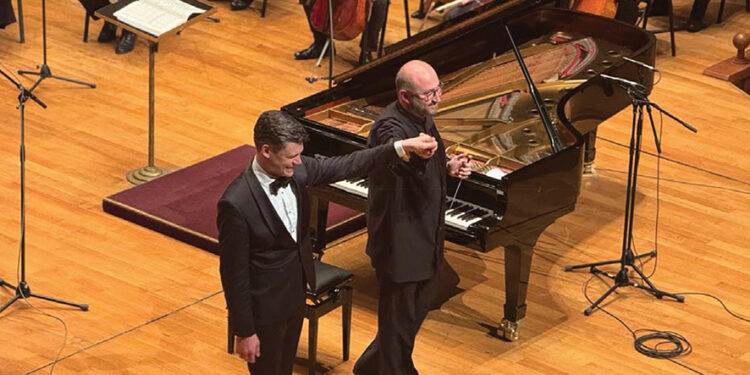On the evening of March 29, the Djansug Kakhidze Tbilisi Center for Music & Culture became a battleground of emotions, where the fervent Romanticism of Pyotr Ilyich Tchaikovsky met the austere and enigmatic world of Jean Sibelius. The Tbilisi Symphony Orchestra, under the guidance of Maestro Revaz Javakhishvili, presented a program of breathtaking contrasts, pairing Tchaikovsky’s Piano Concerto No. 1 with Sibelius’ Symphony No. 2. The concert’s soloist, the celebrated Georgian pianist David Aladashvili, brought both fire and finesse to the evening, turning this performance into a profound dialogue between musical traditions, national identities, and artistic sensibilities.

The Storm of Tchaikovsky: David Aladashvili’s Fiery Virtuosity
If there is one piano concerto that has become synonymous with Romantic grandeur, it is Tchaikovsky’s Piano Concerto No. 1. Opening with its legendary, almost orchestral chordal introduction, this concerto is a relentless display of both technical brilliance and deep emotional turmoil.
David Aladashvili, a pianist with a reputation for blending intellectual precision with expressive depth, took on the formidable challenge with a unique approach. From the first thunderous chords, his playing was neither bombastic nor indulgent; rather, he demonstrated an understanding of Tchaikovsky’s architecture, carefully balancing drama with lyricism. The cadenza in the first movement was not just a display of virtuosity but a moment of storytelling—Aladashvili seemed to shape every phrase with narrative intensity, as though reliving Tchaikovsky’s own personal torments.

The Andantino semplice—the fragile, almost fairy-tale-like second movement—was where Aladashvili’s nuanced touch shone. The pianist is known for his refined, crystalline sound, and here, his delicate phrasing turned the movement into an intimate confession rather than a mere interlude. The orchestra, under Javakhishvili’s sensitive direction, provided a shimmering backdrop, allowing Aladashvili’s playing to breathe and unfold naturally.
The final movement was an explosion of rhythmic energy. Tchaikovsky, always inspired by Russian folk music, fills this Allegro con fuoco with relentless syncopations and dance-like motifs. Aladashvili attacked the finale with controlled ferocity, making it clear that he understood the movement’s raw power without letting it descend into mere bravado. The chemistry between the pianist and the orchestra was palpable, with Javakhishvili keeping the ensemble taut and responsive.

Sibelius’ Second Symphony: A Nordic Epic in a Georgian Context
After the fire of Tchaikovsky, the transition to Sibelius’ Symphony No. 2 was almost cinematic. If the Russian composer’s concerto was a storm, then the Finnish composer’s symphony was a vast landscape—expansive, brooding, and quietly defiant.
Sibelius’ Second Symphony has long been associated with the Finnish national struggle, often interpreted as a subtle but powerful assertion of identity against Russian rule. For a Georgian audience, this context was impossible to ignore. Much like Finland, Georgia has had to navigate the tensions between cultural preservation and external political pressures. In this sense, the symphony’s inclusion in the program felt pointed: was this a reminder of the power of art in shaping national consciousness?

Javakhishvili approached the first movement with patience, allowing the opening theme—softly murmuring strings—to emerge organically. The Tbilisi Symphony Orchestra, known for its lush string section, delivered the warm textures that make Sibelius’ symphony so distinct. Unlike the sweeping melodicism of Tchaikovsky, Sibelius’ music moves in broad, tectonic shifts. Here, Javakhishvili’s skill as a conductor was on full display, building the movement’s momentum with architectural clarity.
The second movement, an elegiac Andante, was where the performance reached its deepest emotional resonance. The haunting pizzicato opening, answered by mournful wind solos, felt like a lament—perhaps for a Finland of the past, or for any nation that has struggled for its autonomy. The Tbilisi Symphony’s brass section, often a highlight of the orchestra, gave the climactic outbursts a raw, almost primal quality.
By the time the third movement arrived—a restless Scherzo that barely allows the listener to breathe—the tension was palpable. The sweeping final movement, often called Sibelius’ great “freedom symphony,” exploded into its majestic finale. The brass fanfare, rising inexorably like a national anthem being born, was a moment of sheer transcendence. The Tbilisi Symphony Orchestra, under Javakhishvili’s baton, captured the grandeur without overstatement. The final chords rang out with the kind of authority that made one believe, at least for a moment, in the redemptive power of music.

A Music to Reflect Upon
This concert was more than a showcase of brilliant musicianship. In its very structure, it posed an implicit dialogue between two artistic worlds: the impassioned, often self-destructive emotionalism of Tchaikovsky and the measured, nationalist resilience of Sibelius.
For Georgia, a country that continues to navigate its complex post-Soviet identity, these works resonate on multiple levels. Tchaikovsky’s music, deeply beloved in Georgia, carries the weight of imperial history, while Sibelius represents a model of cultural independence through artistic perseverance. Could this pairing be read as a statement on Georgia’s own aspirations—to honor its historical ties while forging a distinct and self-determined future?

Both David Aladashvili and Revaz Javakhishvili seem to embody this balance in their artistic choices. Aladashvili, despite his international career, remains deeply connected to his Georgian roots, bringing a uniquely national sensibility to his interpretations. Javakhishvili, as one of the leading conductors in the country, has consistently sought to expand the repertoire of Georgian orchestras, bringing in lesser-performed works like Sibelius’ symphonies.
Ultimately, this was a concert of more than just music: it was a statement. Whether intentional or not, it reminded the audience of the power of cultural memory, of the stories embedded within sound, and of the unspoken dialogues that music creates across time and borders.
By Ivan Nechaev














